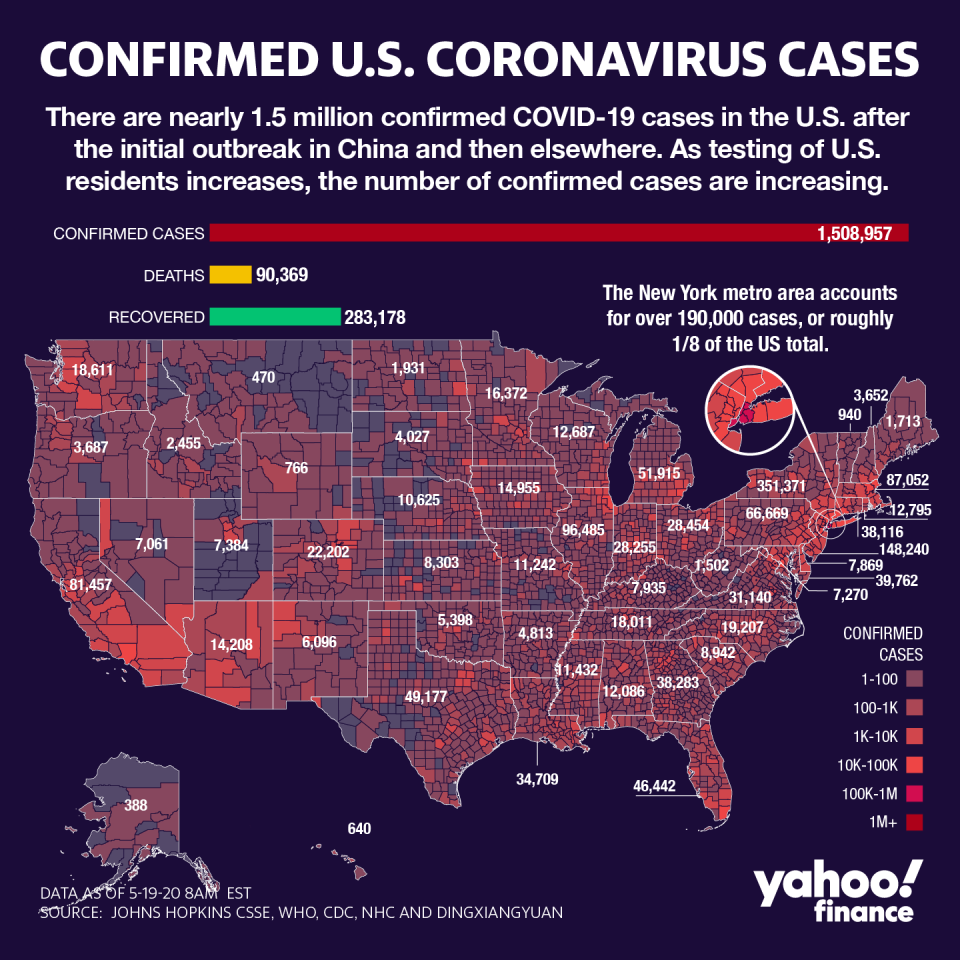Over 4 million in US will contract coronavirus if states fully reopen: Wharton model
New numbers from the Penn Wharton Budget Model show that reopening states could cause positive coronavirus case numbers to tick as high as 5.4 million by July 24.
The model explores various scenarios under which states reopen, include continuing lockdowns, and a partial reopening. The model also forecasts those scenarios if social distancing rules continue to be adhered to or are relaxed.
For the PWBM forecast, the model considers that states reopen on May 18. All totals are cumulative, and include past positive cases and deaths.
If states fully reopen with no social distancing rules in place, as many as 5.4 million people could test positive for coronavirus. And if states reopen while still practicing measures of social distancing, nearly 4.3 million people are projected to be diagnosed with COVID-19 by the third week of July.
Partially reopening the states with social distancing rules in place would result in nearly 3.2 million positive cases.
The forecast represents a large uptick in positive cases in the United States which currently stands at 1.5 million, according to the Johns Hopkins coronavirus tracker.
And according to the PWBM, the number of deaths would also start to rise as states reopen.

While previous forecasts from the University of Pennsylvania model had projected a death toll as high as 350,000, the new numbers are lower, though still higher than other models.
Even with states under a full lockdown, the model has projected a death toll at just over 156,000, a slight increase from its previous forecasts of 117,000.
The current death toll in the United States stands at nearly 91,000, according to Johns Hopkins.
But while this scenario is grim, it only serves as the baseline as more and more states reopen and others mull when and how to let business and other normal activities resume.
With a partial reopening, the model forecasts, the death toll will rise to 173,000 people. A full reopening would result in 231,000 deaths. If all the states reopened without adhering to social distancing guidance, that number leaps to 293,000.
While these numbers are large, they represent a revision downward from Wharton’s previous forecast of 350,000. They are also much larger than other models.
According to the University of Washington Institute for Health Metrics and Evaluation (IHME) model, the current projected death toll stands at roughly 144,000 by Aug. 4.
While the forecasts seem to warn against a full reopening of states, the model does project positive data economically if states reopen.

Keeping states in lockdown with full social distancing in place will cause U.S. GDP to shrink by 10.8% year over year by July 24, but reopening states would save the U.S. from the severe economic losses.
Towards the end of July the model forecasts, if states reopen GDP would decline by 7.7% compared to the year prior. And if social distancing is reduced, GDP would decline by 6.6%.
Reopening states would also impact unemployment figures. More than 36 million Americans million have filed unemployment insurance claims over the past two months, and Wharton’s model projects that keeping states in lockdown would cause millions more to lose their jobs.
A full reopening of states, however, would at least in part reverse that trend, with over a million jobs created in the third week of July, according to the Wharton model.
Kristin Myers is a reporter at Yahoo Finance. Follow her on Twitter.
Read more:
Greatest increases of COVID deaths projected in Republican states
Projected US coronavirus death toll rises to 138,000 as more states mull reopening
Reopening states: No ‘clear’ federal guidance: Kansas City Mayor
Reopening meat plants amid coronavirus a 'huge step backwards': Iowa mayor
Reopening states will cause 233,000 more people to die from coronavirus, according to Wharton model
Read the latest financial and business news from Yahoo Finance
Follow Yahoo Finance on Twitter, Facebook, Instagram, Flipboard, LinkedIn, YouTube, and reddit.

 Yahoo Finanzas
Yahoo Finanzas 
